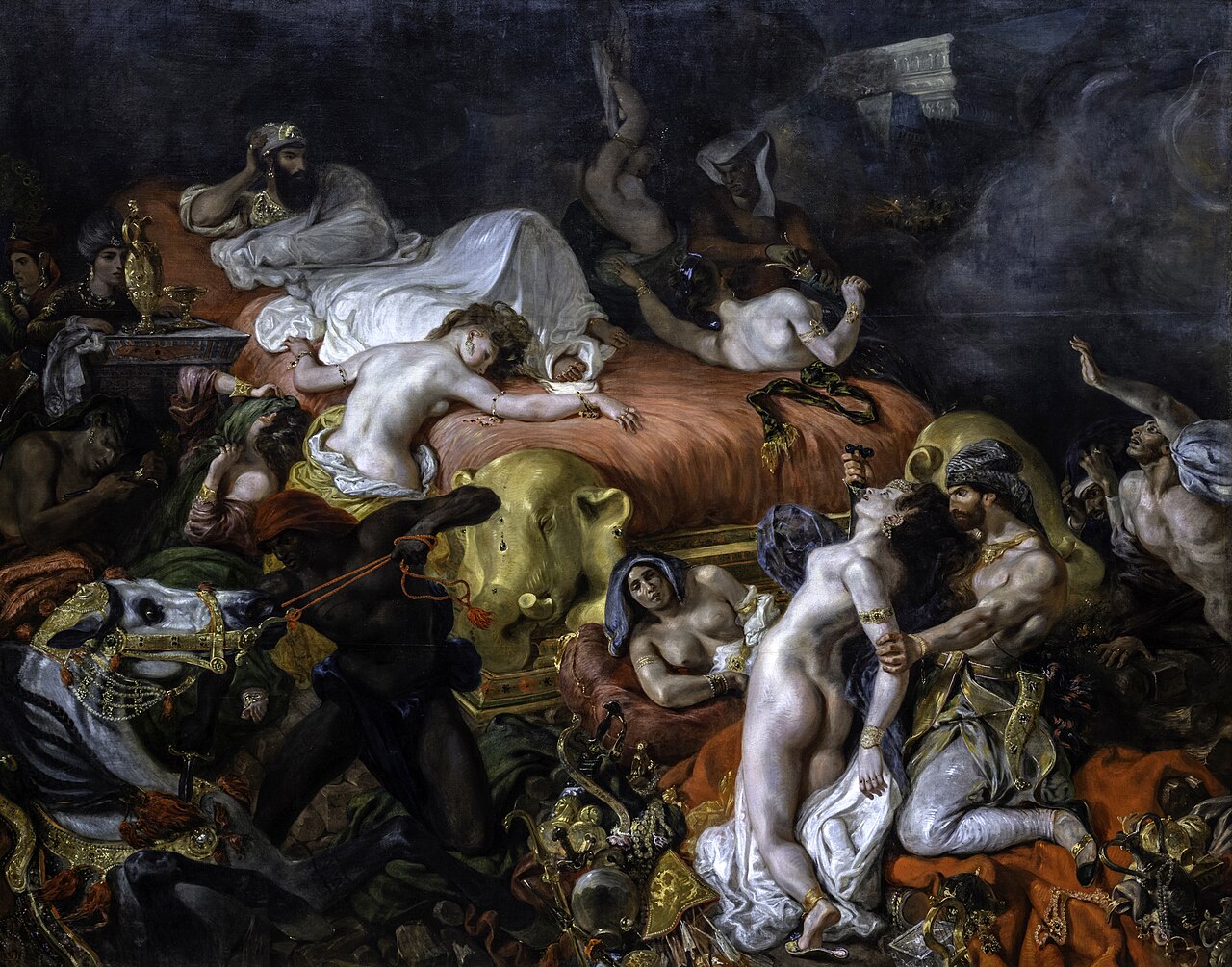
Robert Draws – The Death of Sardanapalus is one of Eugène Delacroix’s most famous and captivating paintings. Delacroix created this work of art in 1827, renowned for its vibrant colors and dramatic composition. It depicts King Sardanapalus’s death, a legendary Assyrian king, as told in Lord Byron’s narrative poem. The painting fills the viewer with chaos, passion, and intense emotions, making it an iconic piece of the Romantic era.
Delacroix’s The Death of Sardanapalus is based on a dramatic historical legend. The king faces a rebellion that threatens his rule. Instead of surrendering, he orders the destruction of his servants, concubines, and treasures. Overcome by despair, he chooses death in his final defiance. Delacroix captures this emotional climax with a stunning visual representation.
In the painting, Delacroix reveals the overwhelming violence and despair of the scene. The composition is filled with dynamic movement. Additionally, Delacroix uses dramatic contrasts between light and dark to create chaos. The king’s futile resistance appears as a storm of destruction. Everything around him burns and is consumed by violence. Furthermore, Delacroix uses chaos to symbolize the collapse of an empire. He vividly illustrates the futility of power when faced with inevitable ruin.
This composition doesn’t merely represent a historical moment, but a profound exploration of human emotions and the fragility of power. As a result, the painting forces viewers to confront the ultimate downfall of Sardanapalus’ once mighty reign. Thus, Delacroix illustrates not only the physical destruction but also the emotional collapse of a ruler who chose defiance over surrender. The fiery chaos becomes a metaphor for the inevitable disintegration of the king’s empire. In conclusion, the scene captures a timeless truth about the impermanence of power and the overwhelming force of fate.
Delacroix was a leading figure of the Romantic movement, which emphasized emotional expression and intense human experiences. The Death of Sardanapalus reflects Romanticism’s essence, focusing on dramatic emotion and vivid imagery. Delacroix’s use of rich, bold colors and wild brushstrokes enhances the scene’s intensity.
The emotional power of the painting intensifies through the characters. Sardanapalus shows profound despair, resigned to his fate. His body language, surrounded by the chaos of his empire’s fall, expresses helplessness. The women and servants appear in anguish, adding to the sense of violence and sorrow.
The swirling motion of the figures and overwhelming composition contribute to the sense of a world spiraling out of control. Delacroix wasn’t merely illustrating a historical event; he captured the emotional turmoil of facing ruin and destruction.
One of the most significant aspects of The Death of Sardanapalus is Delacroix’s exploration of power and downfall. Sardanapalus, once a mighty king, is now powerless in the face of destruction. His once-great kingdom is reduced to fiery ruins. Delacroix seems to ask: what is the value of power when it is fleeting?
The burning palace, the bloodshed, and the dying figures all symbolize the collapse of an empire. Delacroix captures the fleeting nature of power, showing that no matter how great a ruler is, all things are subject to destruction. The contrast between the king’s past grandeur and current devastation reminds viewers of the transient nature of life and power.
Delacroix’s The Death of Sardanapalus greatly influenced Western art. The painting challenged classical ideals of calm and order. It embraced a more expressive, dramatic approach, inspiring future artists. Delacroix’s use of color and movement influenced the Impressionist movement. His work remains celebrated for its emotional depth and intensity.
The painting also changed how historical and mythological subjects were portrayed. Delacroix’s approach was emotional and subjective. Traditional depictions often emphasized factual accuracy. The Death of Sardanapalus shows history can be interpreted through emotion and experience. This makes the work deeply personal and powerful.
“Read more: Emeril Lagasse: The Master of Cajun and Creole Cuisine”
The Death of Sardanapalus remains one of Eugène Delacroix’s most important works, admired for its technical brilliance and emotional depth. The painting symbolizes the fragility of power, the destructive force, and the inevitability of decline. Delacroix’s dramatic portrayal of the tragic legend left a lasting impact on the art world. His work influenced generations of artists to explore themes of emotion, chaos, and the fall of empires.
The painting continues to captivate audiences with its vibrant colors, intense emotion, and timeless themes. The Death of Sardanapalus will forever stand as a symbol of artistic innovation and emotional storytelling. It marks a pivotal moment in art history, showing the world a new way to depict emotional intensity and the downfall of power.